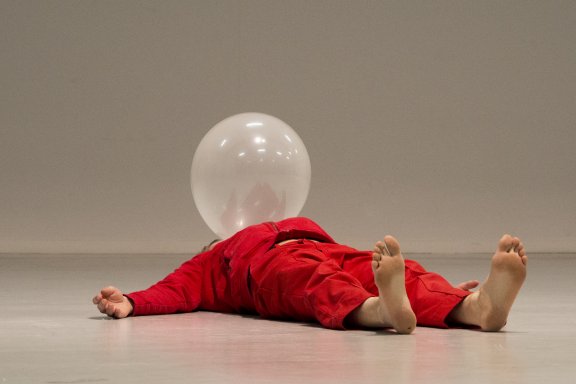30.03 & 2.04.22
CN D à Pantin
Fifteen years after its creation, Olga de Soto revisits this first "accompanied solo" in which, from the background, she follows a dancer whose dance sees the relationship to the object at the heart of the action.
What can we do with the air we breathe or the water we drink? What happens in our bodies or objects? Can we blow into a balloon until it pops? Can we inhale or exhale air through water? How can we create waves or a storm inside a balloon? To incorporate air, water, their sounds, the space; to create one body out of many; to intimately unite one matter with another into an entirely new element, bring them in as parts of a whole, defined, demarcated. Lend body and resonance to the actions and sounds of a wandering that unfolds near the action, in the intimate gesture of one whose attention is fully absorbed by the observation of his explorations.
Thus, in INCORPORER, the dancer is an explorer, uncovering a dance where movement arises from observation and exploring different states of matter and the two fluids necessary for life: air and water to explore a series of physical experiences that he unfolds in space, like a physician in the laboratory. Through the dance that emerges with each new experience, he weaves a dialogue with ordinary and simple objects, discovers the possibilities of his body and the resistance of the materials while gradually making the inaudible audible to unfold a poetic universe that plays with scale and with our perception. The sound work subtly amplifies the performer's actions to make the subterranean life of his organism resonate in this dialogue with the elements.
Through this physical relationship with the environment, between exchanges of fluids and transfers of energy, INCORPORER | KIDs reveals the immediate relationship of a dancer to the physical world. This physicality is simply laid bare, and that takes on the appearance of combat and a fusion with the invisible in a journey full of suspense, guiding him to act with complete freedom.
This piece exists in different versions and can be presented on a conventional theatre stage or in an exhibition space, for an adult audience or a young audience.
Olga de Soto is a choreographer, performer and dance researcher based in Brussels. After training in Spain, her native country, she joined the Centre national de danse contemporaine (Cndc) in Angers, from which she graduated in 1989. She began her creative work, focused on choreographic research and composition, in 1992, exploring numerous works in different formats. Since the early 2000s, her work focuses on the themes of memory, trace, and transmission and mixes the language of choreography with those of documentary, performance, visual arts, and installation, playing with the porousness of those disciplines. It deploys along two lines. The first concentrates on studying the dancer's kinesthetic memory through a pluralistic approach to dance and the body. In the second, she explores works from the history of dance from the perspective of the perceptual memories of both spectators and dancers. The resulting projects deal with archives, documentation, testimony, oral sources, narrative, and storytelling. anthropological approach has led her to be invited to share her methodology in academic contexts and to present her pieces around the world. In 2013, Olga de Soto was awarded the Society of Dramatic Authors and Composers - SACD Prize (Belgium), in the category of Performing Arts, for her research and creative work on Kurt Jooss' The Green Table. Since 2019, she is also a guest lecturer at the Master in Dance of the Antwerp Conservatory / Artesis Plantijn Hogeschool Antwerpen.
Max Fossati is a dancer based in Paris. After completing his training at the CNDC in Angers and then at EXERCE in Montpellier, he went on to meet Alban Richard in 2002, participating in the creation of almost all of his pieces. In 2008, he joined d a n s e by Rosalind Crisp, a continuous choreographic process alternating research and performance. He has danced for many choreographers including Christine Gaigg, Olivia Granville, Odile Duboc, Lionel Hoche and Gabriel Hernàndez. He has a DE in dance teaching and works in different contexts and with different audiences. Laureate in 2018 of the Royaumont Foundation, he developes the performance PLAINand will create his first solo Inaccessible vallée in autumn 2023.
